The Impact of Fixed-Tilt PV Arrays on Vegetation Growth Through Ground Sunlight Distribution at a Solar Farm in Aotearoa New Zealand
Abstract
1. Introduction
Objective of the Paper
- What proportion of land receives high, moderate, or low irradiance?
- How does the fixed-tilt PV array influence the spatial and seasonal distribution of PPFD?
- Which vegetation types are best suited to each irradiance zone?
- What are the implications for agrivoltaic design and land-use policy in the Aotearoa New Zealand context?
2. Literature Review
2.1. Review Methodology
2.2. Key Themes in the Literature
2.2.1. PV Impacts on Light and Microclimate
2.2.2. Modelling Light Distribution Under PV Systems
2.2.3. Vegetation Suitability Under PV Systems
2.2.4. Light Availability and Photosynthetic Efficiency
2.2.5. Ecological and Land-Use Implications
2.2.6. Gaps in Current Modelling Practice
2.2.7. Pasture and Herd-Based Agrivoltaic Studies
2.3. Conclusions
3. Research Methods
3.1. Research Design
3.2. Case Study: Tauhei Solar Farm, Waikato
3.3. Modelling Approach
Python Model Overview
- The study area was divided into 1 m × 1 m cells to sample light at a practical resolution.
- For each hour, compute using sun elevation and azimuth and project the panel (polygon) onto the ground to obtain a shadow shape; intersect that shape with each grid cell to obtain the beam shading fraction per cell to obtain the shading factor.
- Compute ground irradiance using hourly DNI and DHI from SolarGIS with the shading factor to compute the ground irradiation.
- Render heat maps of the ground GHI as well as PPFD using relevant python libraries.
- Pandas 2.2.3: tabular data handling (read SolarGIS csv filess; time indexing; seasonal aggregation).
- NumPy 2.2.0: fast array math for solar angles and shading matrices.
- Shapely 2.0.6: geometric operations on polygons (shadow projection, intersection with grid cells, and area calculations).
- GeoPandas 1.0.1: geospatial DataFrame that pairs each grid cell geometry with its computed values and makes plotting straightforward.
- Matplotlib 3.10.0: plotting library used to render the heat maps and export publication-quality figures with consistent colour scales.
3.4. System Parameters
3.4.1. Assumptions
- Panels are opaque and block all direct beam radiation beneath their structure.
- Diffuse irradiance is assumed to be isotropic (evenly distributed across the sky dome).
- Ground reflectance and albedo effects are ignored.
- Soil and vegetation characteristics are assumed to be uniform throughout the study area.
3.4.2. Solar Array Technical Specifications
- Array width: 4530 mm;
- Array length (row length): 14,970 mm;
- Panel tilt angle (β): 20°;
- Lowest panel edge height (Hpanel): 900 mm;
- Highest panel edge height (Hpanel, top): 2600 mm;
- Row Spacing (pitch): 3250 mm.
3.4.3. Panel Geometry and Study Area
- Panel height (Hpanel): Distance from ground to the lowest panel edge.
- Panel tilt (β): Angle between the panel surface and horizontal.
- Solar zenith angle (Z): Angle between the sun and the vertical.
- Solar azimuth angle (γs): Direction of the sun’s position.
- Panel azimuth angle (γp): Orientation of the panel.
3.5. Irradiance Modelling and Shading Factors
3.5.1. Direct Beam (Direct Normal) Irradiance and Direct Beam Shading Factor
3.5.2. Diffuse Irradiance
3.5.3. Diffuse Shading Factor
3.6. Simulation and Analysis: The Model
3.6.1. Shadow Projection Beneath the PV Panels
- x-axis: East–West direction;
- y-axis: North–South direction;
- z-axis: Vertical (upward).
- v1 = (−7.284, 0, 0.9)
- v2 = (7.284, 0, 0.9)
- v3 = (7.284, 7.257, 2.6)
- v4 = (−7.284, 7.257, 2.6)
3.6.2. Data Source and Preprocessing
3.6.3. Estimating Ground Irradiance, GHIground, in the Study Area
3.6.4. Estimating Photosynthetic Photon Flux Density (PPFD)
3.6.5. Seasonal Comparisons via Solstices and Equinoxes
- Summer solstice (21 December);
- Winter solstice (21 June);
- Spring equinox (22 September);
- Autumn equinox (21 March).
3.6.6. Irradiance Heat Maps
3.7. Limitations
4. Results
4.1. Beam Shading Factors
- 1 means full shading (no direct beam reaching the ground);
- 0 means no shading (full direct beam reaches ground).
4.2. Model Results for the Global Ground Irradiance
4.2.1. Day Visualization of the Equinoxes and Solstices
4.2.2. Spatial Heat Maps for Ground Irradiance
4.2.3. Comparison Between Solar Resource and GHIground
4.3. The Model Results for the Photosynthetic Photon Flux Density (PPFD)
4.3.1. Daily Average PPFD Across the Seasonal Cycle
4.3.2. Spatial Distribution of Daily Average PPFD Across Seasons
4.3.3. Seasonal Average PPFD Across the Study Area
4.4. Summary of Averaged Ground Irradiance and PPFD Results by Season
4.5. Vegetation Suitability Under Light Conditions
4.6. Sensitivity Analysis
4.6.1. Sensitivity to Panel Tilt and Orientation (Panel Azimuth)
4.6.2. Sensitivity to an Anisotropic Environment
5. Discussion
5.1. Seasonal Trends and Shading Dynamics
5.2. Spatial Light Distribution and Ground-Level Variability
5.3. Interpretation of Seasonal PPFD Values and GHI Reduction
5.4. Crop Suitability Based on PPFD Thresholds
5.5. Limitations, and Policy Relevance
6. Conclusions
6.1. Recommendations for Policy and Practice
- Incorporate agronomic criteria into solar farm planning: Regulatory and permitting bodies should consider mandating vegetation-light modelling as part of environmental impact assessments for new PV farms, especially in agricultural zones.
- Encourage dual-use land strategies: This research supports national policies promoting land-use optimization. Integrating solar PV with grazing or shade-tolerant cropping could increase land efficiency and socio-ecological resilience.
- Establish vegetation monitoring baselines: Ongoing empirical studies at operational solar farms should monitor vegetation health, light variability, and species adaptation to inform future development guidelines.
- Site-specific light management: Developers should use light zoning maps to guide panel spacing, tilt, and layout adjustments that enable vegetative growth beneath or adjacent to arrays without compromising energy output.
- The first two policy-related actions, especially, will improve the current land-use regulations in Aotearoa New Zealand in terms of informing, and addressing some of the challenges of, the resource consenting process of solar farms [49]—also referred to as environmental authorization in other countries.
6.2. Recommendations for Further Research
- The framework needs to be extended to single-axis tracking with backtracking to ensure maximization of both energy yield and vegetation productivity.
- Empirical validation using spectroradiometers or quantum sensors beneath installed PV panels is essential. Ground measurements in different seasons and at different times of day will help calibrate the model and adjust for real-world deviations, particularly during variable cloud conditions.
- Derive uncertainty margins by logging PPFD and GHI with quantum meter and pyranometers, respectively, in the research study area—below panel, edge, and inter-row zones throughout the seasons—to compute root mean square error (RMSE), mean absolute error (MAE), and bias (mean error) against the model outputs.
- Crop modelling tools could be integrated with light simulations to assess actual biomass or yield projections under modified light regimes. Model microclimate interactions (for example, evapotranspiration).
- Extend this analysis to different regions of Aotearoa New Zealand with varying climatic and ecological conditions.
Author Contributions
Funding
Data Availability Statement
Acknowledgments
Conflicts of Interest
Abbreviations
| DHI | Diffuse Horizontal Irradiance |
| DNI | Direct Normal Irradiance |
| GHI | Global Horizontal Irradiance |
| PPFD | Photosynthetic Photon Flux Density |
| SLRM | Solar and Longwave Radiation Model (SLRM) |
| SPA | Solar Positioning Algorithm |
References
- Ministry for the Environment. New Zealand’s Projected Greenhouse Gas Emissions to 2050. Available online: https://environment.govt.nz/what-government-is-doing/areas-of-work/climate-change/emissions-reductions/emissions-reduction-targets/new-zealands-projected-greenhouse-gas-emissions-to-2050/ (accessed on 14 August 2025).
- Ministry of Business, Innovation & Employment. Consultation Document: Advancing New Zealand’s Energy Transition. Available online: https://www.mbie.govt.nz/building-and-energy/energy-and-natural-resources/energy-consultations-and-reviews/advancing-new-zealands-energy-transition-consultation-document (accessed on 14 August 2025).
- Concept Consulting. Generation Investment Survey: 2023 Update. Prepared for the Electricity Authority. Available online: https://www.ea.govt.nz/documents/4414/Generation_Investment_Survey_-_2023_update.pdf (accessed on 14 August 2025).
- Brent, A.C.; Iorns, C. Solar Farms Can Eat up Farmland–But ‘Agrivoltaics’ Could Mean the Best of Both Worlds for NZ Farmers. The Conversation. 2024. Available online: https://theconversation.com/solar-farms-can-eat-up-farmland-but-agrivoltaics-could-mean-the-best-of-both-worlds-for-nz-farmers-230531 (accessed on 14 August 2025).
- Brent, A.C. Agrivoltaic systems for Aotearoa New Zealand. Int. J. Environ. Sci. Nat. Res. 2024, 33, 556357. [Google Scholar] [CrossRef]
- NIWA. Overview of New Zealand’s Climate. Available online: https://niwa.co.nz/climate-and-weather/overview-new-zealands-climate (accessed on 14 August 2025).
- Vaughan, A.; Brent, A.C.; Fitzgerald, M.; Kueppers, J. Agrivoltaics: Integrating Solar Energy Generation with Livestock Farming in Canterbury. Our Land and Water National Science Challenge, Rural Profession Fund Technical Report. June 2023. Available online: https://ourlandandwater.nz/outputs/integrating-solar-livestock-report/ (accessed on 14 August 2025).
- Beechey-Gradwell, Z.; Ali, A.; Shorten, P. Putting the Farm into Solar Farms. MPI Technical Paper 2025/15. December 2024. Available online: https://www.mpi.govt.nz/dmsdocument/68067-Putting-the-Farm-into-Solar-Farms/ (accessed on 14 August 2025).
- Arksey, H.A.; O’Malley, L. Scoping studies: Towards a methodological framework. Int. J. Soc. Res. Method. 2005, 8, 19–32. [Google Scholar] [CrossRef]
- Levac, D.; Colquhoun, H.; O’Brien, K.K. Scoping studies: Advancing the methodology. Implement. Sci. 2010, 5, 69. [Google Scholar] [CrossRef]
- Sarr, A.; Soro, Y.M.; Tossa, A.K.; Diop, L. A new approach for modelling photovoltaic panel configuration maximizing crop yield and photovoltaic array outputs in agrivoltaics systems. Energy Convers. Manag. 2024, 309, 118436. [Google Scholar] [CrossRef]
- Perna, A. Modeling and Optimizing Irradiance Distributions in Agrivoltaic Systems. Master’s Thesis, Purdue University, West Lafayette, IN, USA, 2021. Available online: https://hammer.purdue.edu/ndownloader/files/17970563 (accessed on 14 August 2025).
- Najafabadi, M.K. Shade and Light Modeling for Agrivoltaic Systems: With Focus on Single-axis Agrivoltaic Systems. Master’s Thesis, Lund University, Lund, Sweden, 2024. Available online: http://lup.lub.lu.se/student-papers/record/9151020 (accessed on 14 August 2025).
- Fagnano, M.; Fiorentino, N.; Visconti, D.; Baldi, G.M.; Falce, M.; Acutis, M.; Genovese, M.; Blasi, M.D. Effects of a photovoltaic plant on microclimate and crops’ growth in a Mediterranean area. Agronomy 2024, 14, 466. [Google Scholar] [CrossRef]
- Noor, N.F.M.; Reeza, A.A. Effects of solar photovoltaic installation on microclimate and soil properties in UiTM 50MWac solar park, Malaysia. IOP Conf. Ser. Earth Environ. Sci. 2022, 1059, 012031. [Google Scholar] [CrossRef]
- Gupta, R.; Kumar, M.; Tiwari, R.; Khare, R. Effects of shading in agrivoltaic systems on maize yield: A case study. Appl. Energy 2024, 262, 114564. [Google Scholar]
- Chen, X.; Chen, B.; Wang, Y.; Zhou, N.; Zhou, Z. Response of vegetation and soil property changes by photovoltaic established stations based on a comprehensive meta-analysis. Land 2024, 13, 478. [Google Scholar] [CrossRef]
- Feistel, U.; Werisch, S.; Marx, P.; Kettner, S.; Ebermann, J.; Wagner, L. Assessing the impact of shading by solar panels on evapotranspiration and plant growth using lysimeters. AIP Conf. Proc. 2022, 2635, 150001. [Google Scholar] [CrossRef]
- Hickey, T. Plant Growth Under Photovoltaic Arrays of Varying Transparencies—A Study of Plant Response to Light and Shadow in Agrivoltaic Systems. Master’s Thesis, Colorado State University, Fort Collins, CO, USA, 2023. Available online: https://hdl.handle.net/10217/236849 (accessed on 14 August 2025).
- Ko, D.-Y.; Chae, S.-H.; Moon, H.-W.; Kim, H.J.; Seong, J.; Lee, M.-S.; Ku, K.-M. Agrivoltaic farming insights: A case study on the cultivation and quality of kimchi cabbage and garlic. Agronomy 2023, 13, 2625. [Google Scholar] [CrossRef]
- Potenza, E.; Croci, M.; Colauzzi, M.; Amaducci, S. Agrivoltaic system and modelling simulation: A case study of soybean (Glycine max L.) in Italy. Horticulturae 2022, 8, 1160. [Google Scholar] [CrossRef]
- Scarano, A.; Semeraro, T.; Calisi, A.; Aretano, R.; Rotolo, C.; Lenucci, M.S.; Santino, A.; De Caroli, M. Effects of the agrivoltaic system on crop production: The case of tomato (Solanum lycopersicum L.). Appl. Sci. 2024, 14, 3095. [Google Scholar] [CrossRef]
- RED Horticulture. Measuring Light in Horticulture: PAR, PPF, and PPFD. Available online: https://www.horticulture.red/en/measuring-light-in-horticulture-par-ppf-and-ppfd/ (accessed on 14 August 2025).
- Laub, M.; Ehmann, A.; Weselek, A. Impact of shading on crop yields: A meta-analysis of agrivoltaic systems. Renew. Energy 2022, 150, 280–292. [Google Scholar] [CrossRef]
- Jedmowski, C.; Kherde, S.; Pahwa, A.; Schlechtrimen, V.; Meier-Grűll, M.; Muller, O. Effect of shading in an agri-PV system on structure and growth of ornamental plants. In AgriVoltaics Conference Proceedings; TIB Open Publishing: Hannover, Germany, 2022. [Google Scholar] [CrossRef]
- Sturchio, M.A.; Kannenberg, S.A.; Knapp, A.K. Agrivoltaic arrays can maintain semi-arid grassland productivity and extend the seasonality of forage quality. App. Energy 2024, 356, 122418. [Google Scholar] [CrossRef]
- Kampherbeek, E.W.; Webb, L.E.; Reynolds, B.J.; Sistla, S.A.; Horney, M.R.; Ripoll-Bosch, R.; Dubowsky, J.P.; McFarlane, Z.D. A preliminary investigation of the effect of solar panels and rotation frequency on the grazing behavior of sheep (Ovis aries) grazing dormant pasture. App. Anim. Behav. Sci. 2023, 258, 105799. [Google Scholar] [CrossRef]
- Andrew, A.C.; Higgins, C.W.; Smallman, M.A.; Graham, M.; Ates, S. Herbage yield, lamb growth and foraging behavior in agrivoltaic production system. Front. Sustain. Food Syst. 2021, 5, 659175. [Google Scholar] [CrossRef]
- Andrew, A.C.; Higgins, C.W.; Smallman, M.A.; Prado-Tarango, D.E.; Rosati, A.; Ghajar, S.; Graham, M.; Ates, S. Lamb growth and seasonal herbage production from simple, diverse and legume pastures in an agrivoltaic system. Grass Forage Sci. 2024, 79, 294–307. [Google Scholar] [CrossRef]
- Moretta, M.; Rossi, R.; Padovan, G.; Moriondo, M.; Staglianò, N. The impact of photovoltaic on permanent grassland composition and productivity in central Italy. In AgriVoltaics Conference Proceedings; TIB Open Publishing: Hannover, Germany, 2024; Available online: https://www.tib-op.org/ojs/index.php/agripv/article/view/1372/2662 (accessed on 14 August 2025).
- Madej, L.; Picon-Cochard, C.; Bouhier de l’Ecluse, C.; Cogny, C.; Michaud, L.; Roncoroni, M.; Colosse, D. One year of grassland vegetation dynamics in two sheep-grazed agrivoltaic systems. In AgriVoltaics Conference Proceedings; TIB Open Publishing: Hannover, Germany, 2022. [Google Scholar] [CrossRef]
- Environmental Protection Authority. The Application Documents for the Tauhei Solar Farm. 2022. Available online: https://www.epa.govt.nz/fast-track-consenting/referred-projects/tauhei-solar-farm/the-application/ (accessed on 14 August 2025).
- SLR Consulting. Tauhei Solar Farm: Harmony Energy New Zealand. SLR Projects. 2024. Available online: https://www.slrconsulting.com/projects/tauhei-solar-farm (accessed on 14 August 2025).
- Quaschning, V.; Hanitsch, R. Shade Calculations in Photovoltaic Systems. ISES Solar World Conference, Harare, Zimbabwe, 1995. Available online: https://www.researchgate.net/profile/Volker-Quaschning/publication/268519841_ISES1995/links/546f37d70cf216f8cfa9cb5b/ISES1995.pdf (accessed on 14 August 2025).
- Perez, R.S. A new simplified version of the Perez diffuse irradiance model for tilted surfaces. Sol. Energy 1987, 39, 221–231. [Google Scholar] [CrossRef]
- Essery, R.; Marks, D. Scaling and parametrization of clear-sky solar radiation over complex topography. J. Geophys. Res. Atmos. 2007, 112, D10122. [Google Scholar] [CrossRef]
- McArthur, L.J.B.; Hay, J.E. A technique for mapping the distribution of diffuse solar radiation over the sky hemisphere. J. App. Meteor. Clim. 1981, 20, 421–429. [Google Scholar] [CrossRef]
- Gu, L.; Baldocchi, D.; Verma, S.B.; Black, T.A.; Vesala, T.; Falge, E.M.; Dowty, P.R. Advantages of diffuse radiation for terrestrial ecosystem productivity. J. Geophys. Res. Atmos. 2002, 107, ACH 4-1-ACL 3-1. [Google Scholar] [CrossRef]
- Xia, X. A critical assessment of direct radiative effects of different aerosol types on surface global radiation and its components. J. Quant. Spectrosc. Radiat. Trans. 2014, 149, 72–80. [Google Scholar] [CrossRef]
- Oke, T.R. The energetic basis of the urban heat island. Q. J. R. Meteorol. Soc. 1982, 108, 1–24. [Google Scholar] [CrossRef]
- Danny, H.W.; Li, J.C. Predicting solar irradiance on inclined surfaces using sky radiance data. Energy Conver. Man. 2004, 45, 1771–1781. [Google Scholar] [CrossRef]
- Bosch, J.L.; López, G.; Batlles, F.J. Global and direct photosynthetically active radiation parameterizations for clear-sky conditions. Agric. For. Meteorol. 2009, 149, 146–158. [Google Scholar] [CrossRef]
- Brito, C.; Ferreira, H.; Dinis, L.-T.; Trindade, H.; Marques, D.; Correia, C.M.; Moutinho-Pereira, J. Different LED light intensity and quality change perennial ryegrass (Lolium perenne L.) physiological and growth responses and water and energy consumption. Front. Plant Sci. 2023, 14, 1160100. [Google Scholar] [CrossRef]
- Unruh, J.B. Daily Light Requirements for Grass Species. Lecture, University of Florida. 2015. Available online: https://wfrec.ifas.ufl.edu/media/wfrecifasufledu/docs/pdf/turfgrass/Daily_Light_Requirements_Lawn_Grasses_FTGA_2015_Unruh.pdf (accessed on 14 August 2025).
- Adeh, E.H.; Selker, J.S.; Higgins, C.W. Remarkable agrivoltaic influence on soil moisture, micrometeorology, and water-use efficiency. PLoS ONE 2018, 13, e0203256. [Google Scholar]
- Marrou, H.; Guilioni, L.; Dufour, L.; Dupraz, C.; Wery, J. Microclimate under agrivoltaic systems: Is crop growth hindered by the reduction in solar energy? Agric. For. Meteorol. 2013, 177, 117–132. [Google Scholar] [CrossRef]
- Vignola, F.; Peterson, J.; Kessler, R.; Snider, S.; Gotseff, P.; Sengupta, M.; Habte, A.; Andreas, A.; Mavromatakis, F. Influence of diffuse and ground-reflected irradiance on the spectral modelling of solar reference cells. In Proceedings of the ASES National Solar Conference Proceedings, Boulder, CO, USA, 3–6 August 2021. [Google Scholar] [CrossRef]
- Hernandez, R.R.; Easter, S.B.; Murphy-Mariscal, M.L.; Maestre, F.T.; Tavassoli, M.; Allen, E.B.; Allen, M.F. Environmental impacts of utility-scale solar energy. Renew. Sustain. Energy Rev. 2014, 29, 766–779. [Google Scholar] [CrossRef]
- Brent, A.; Iorns, C.; Brent, A.C. Consenting and developing solar farms in Aotearoa New Zealand: Challenges and way forward. Res. Man. J. 2025, 19–23. [Google Scholar] [CrossRef]
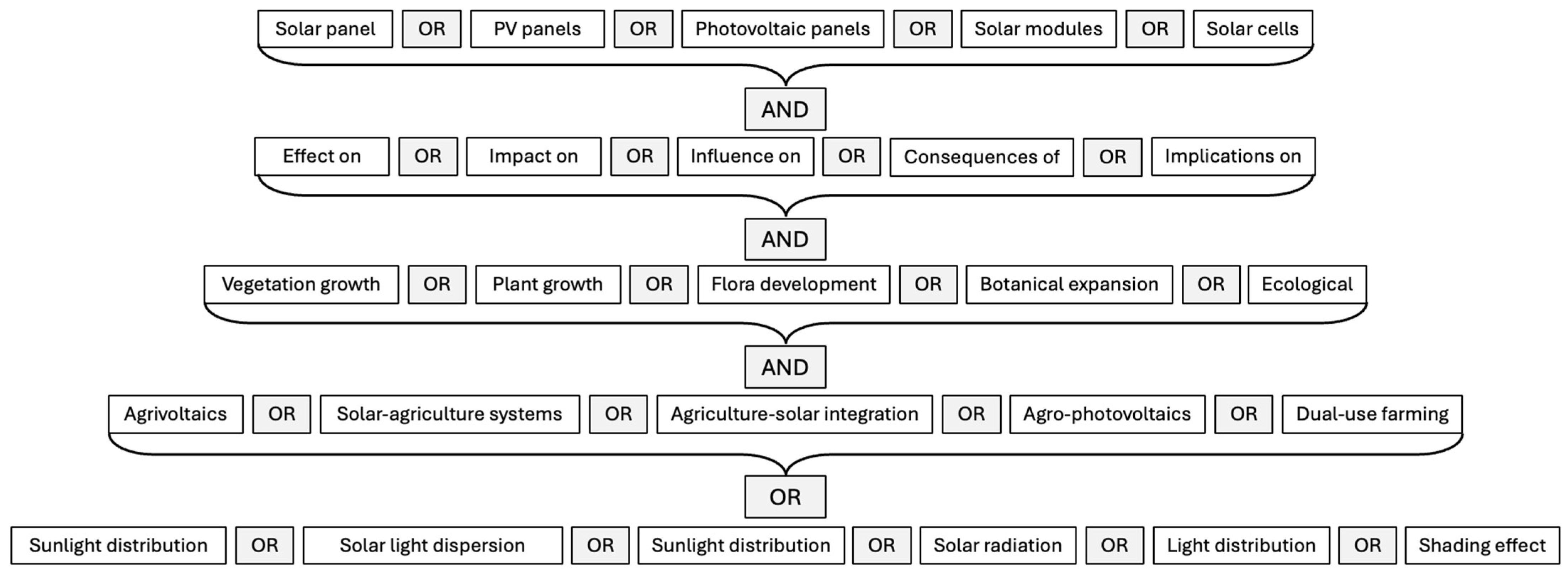
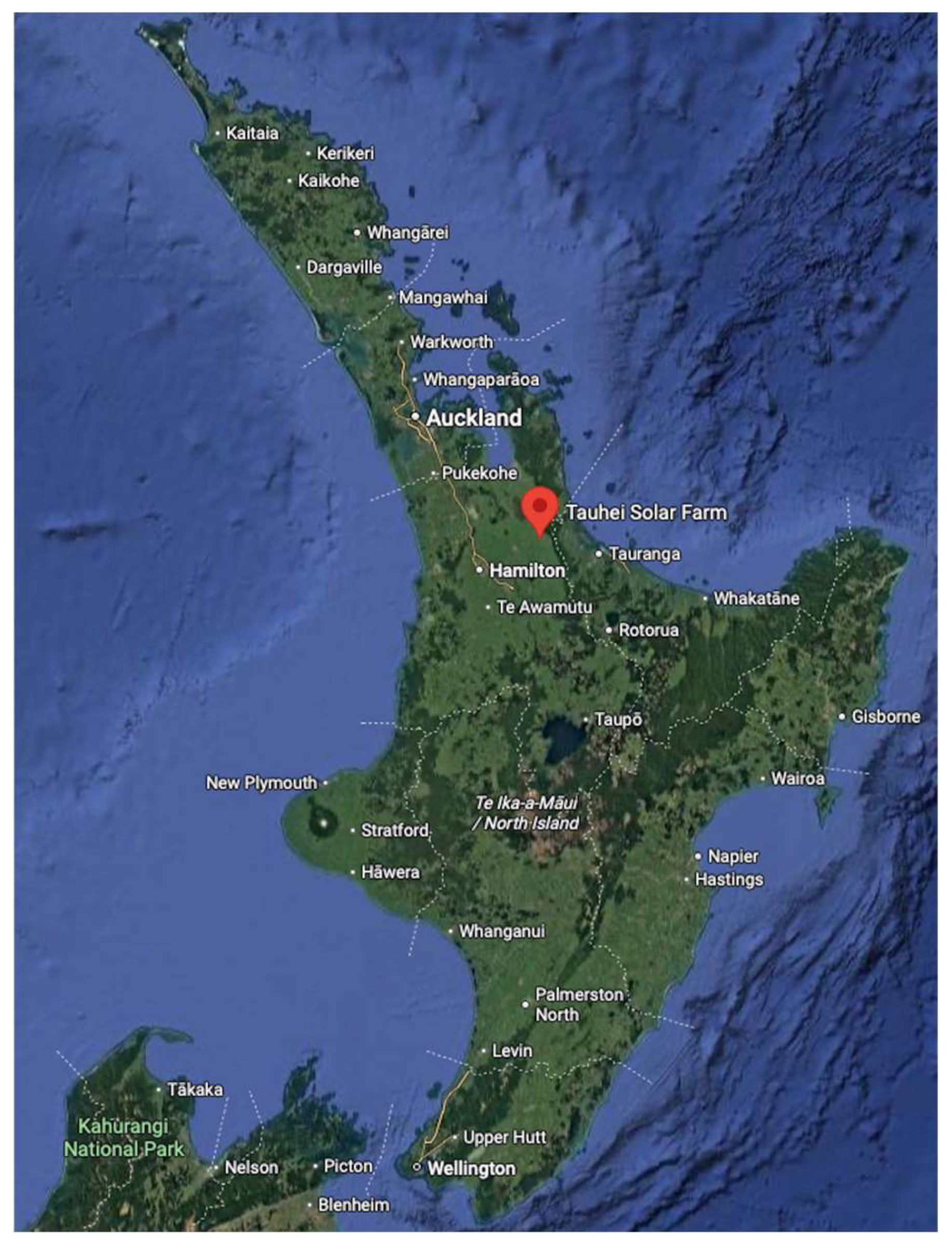

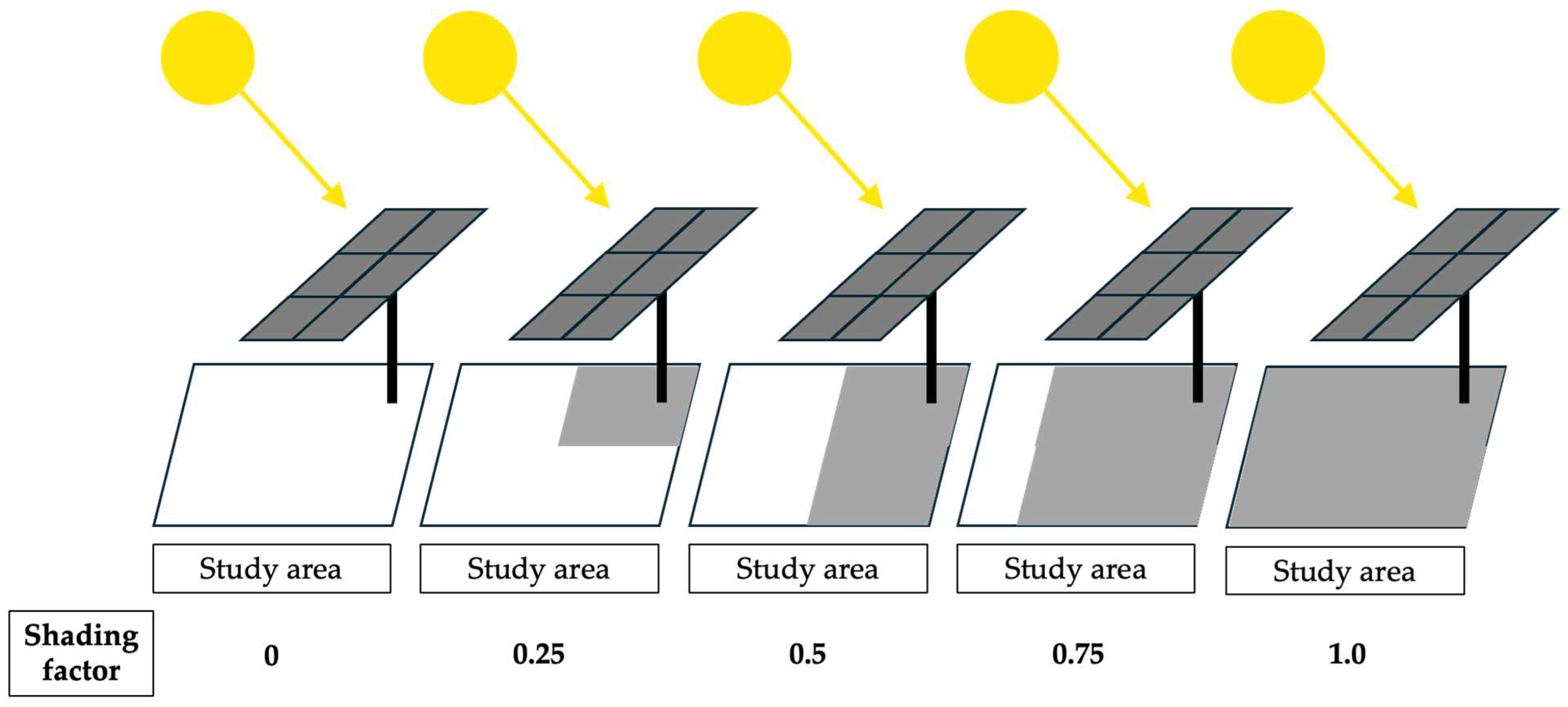
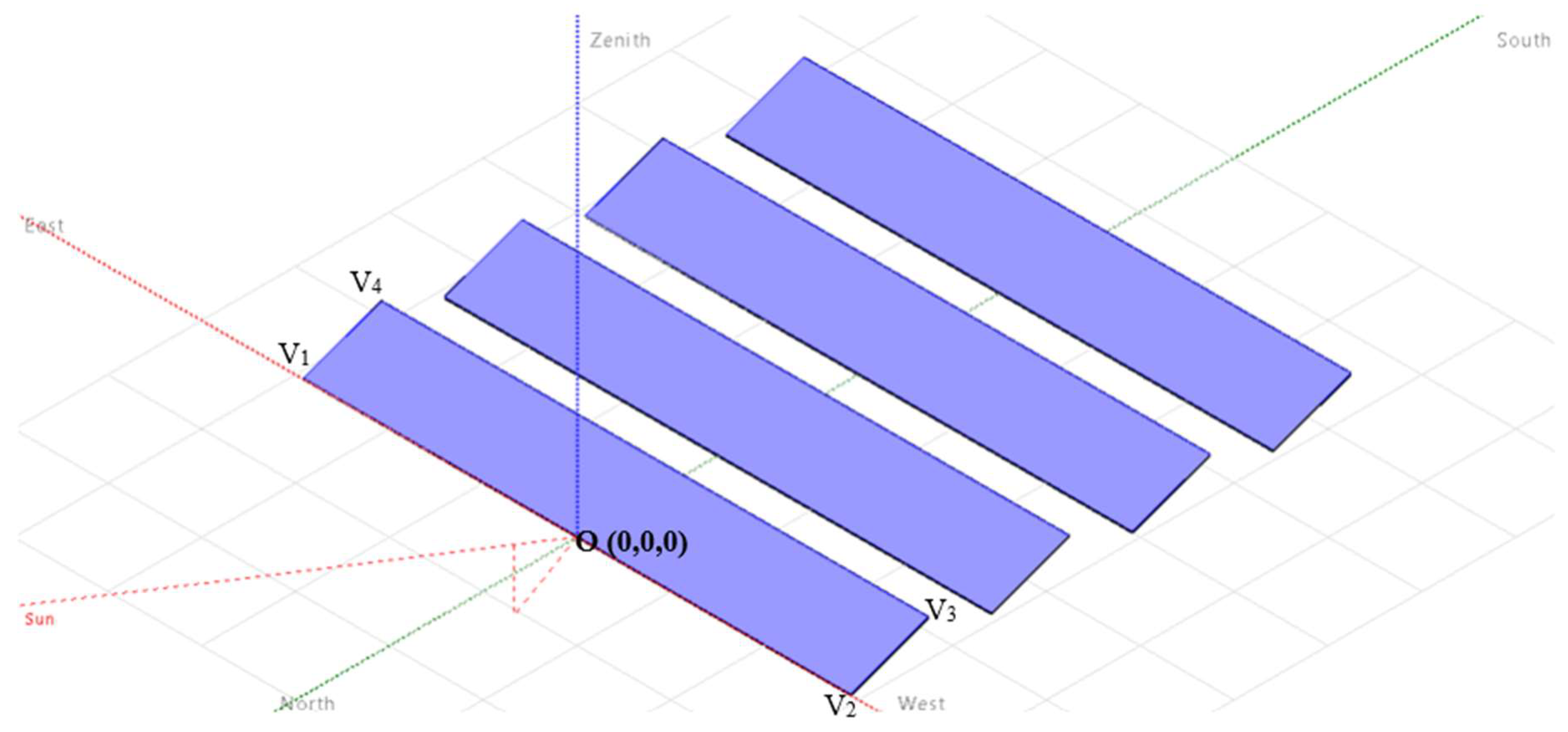
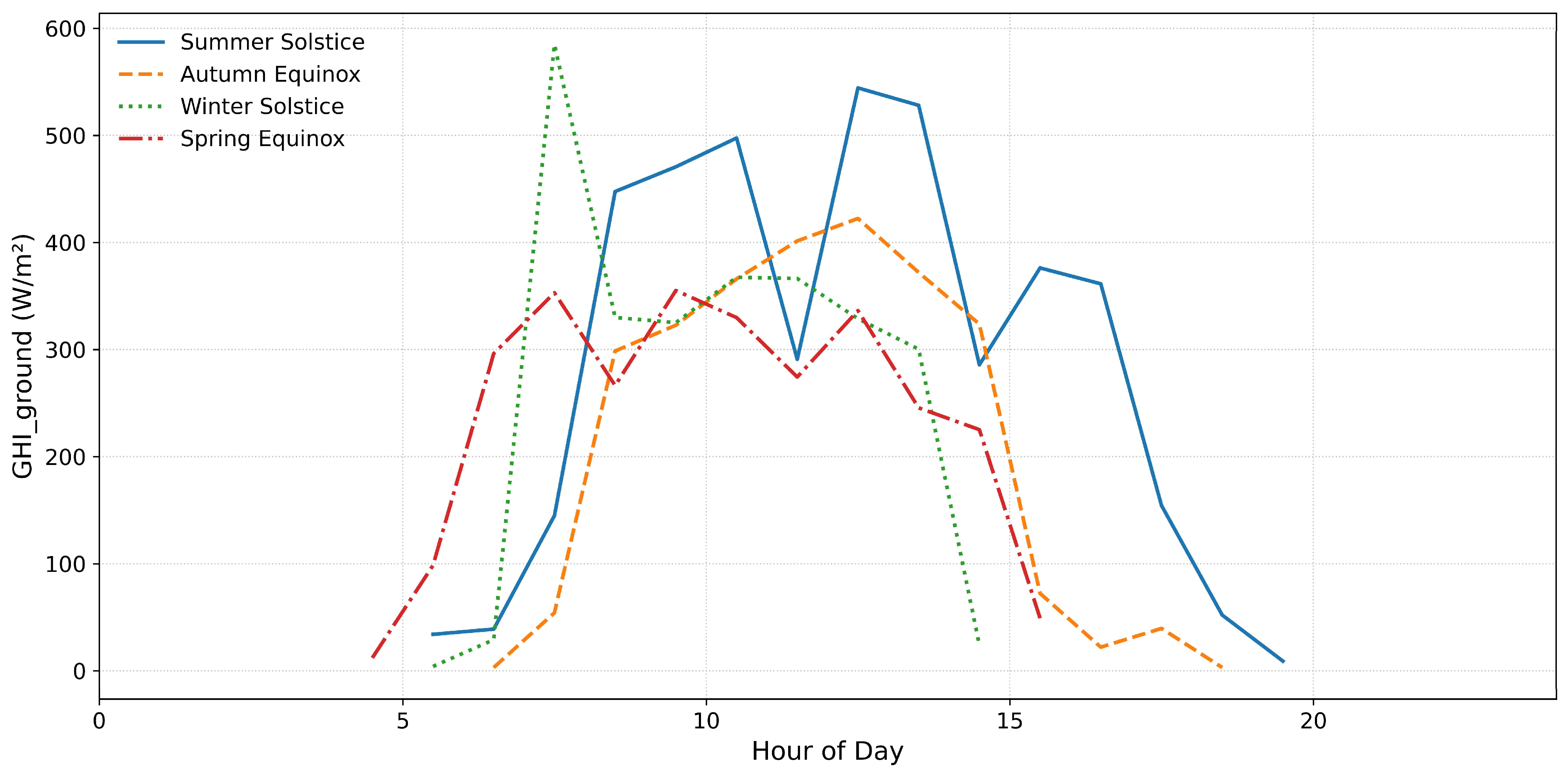
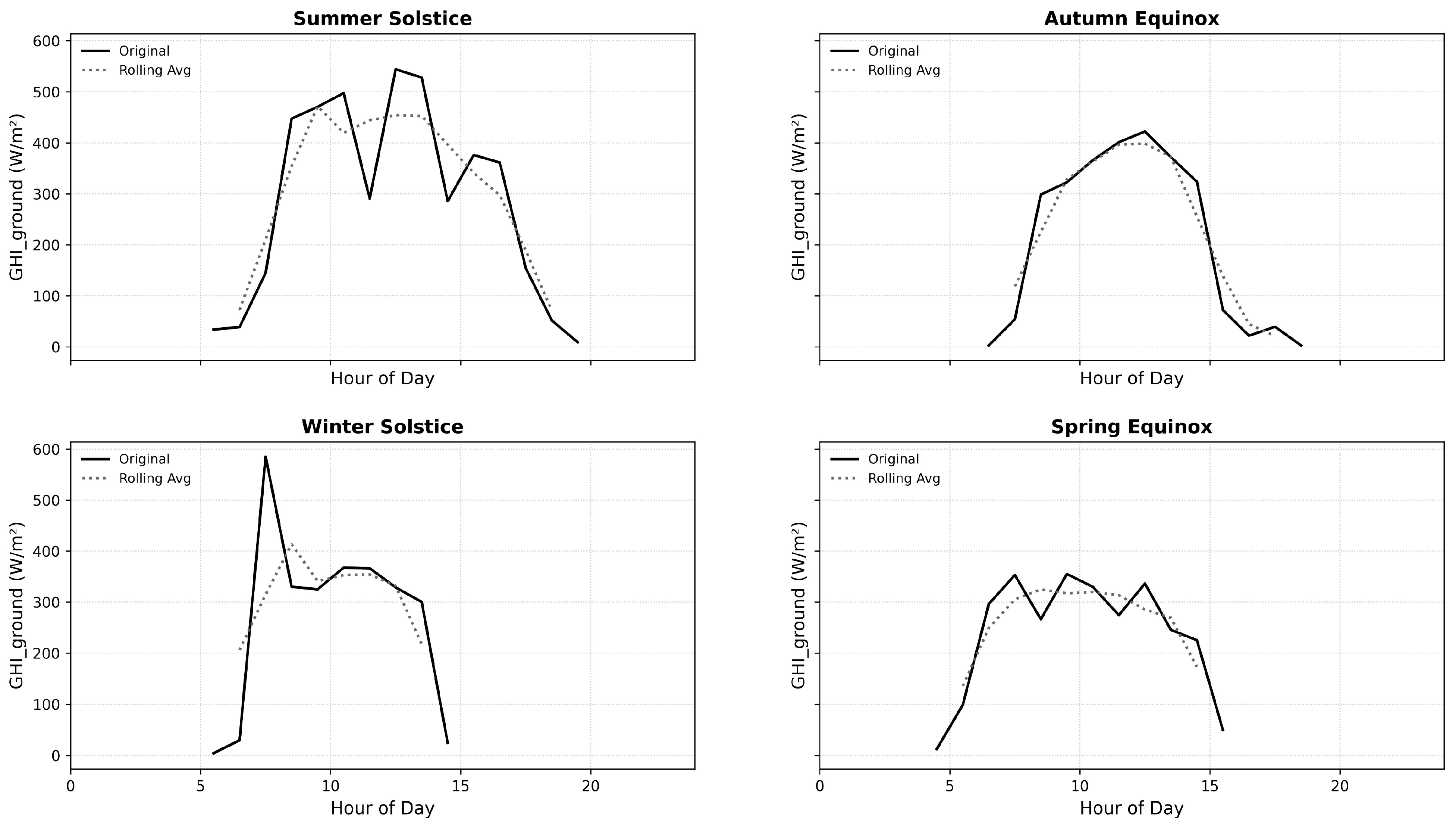
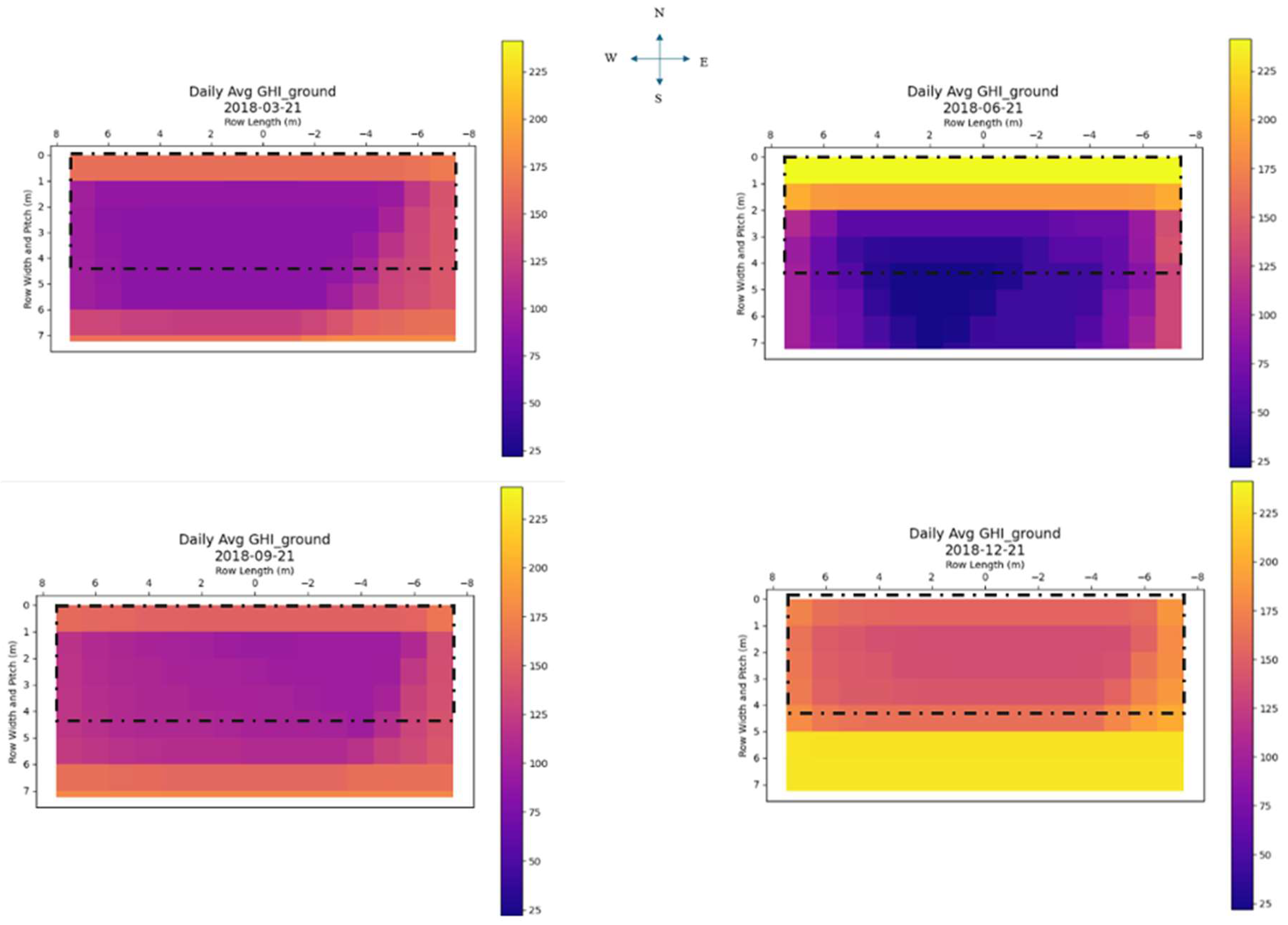
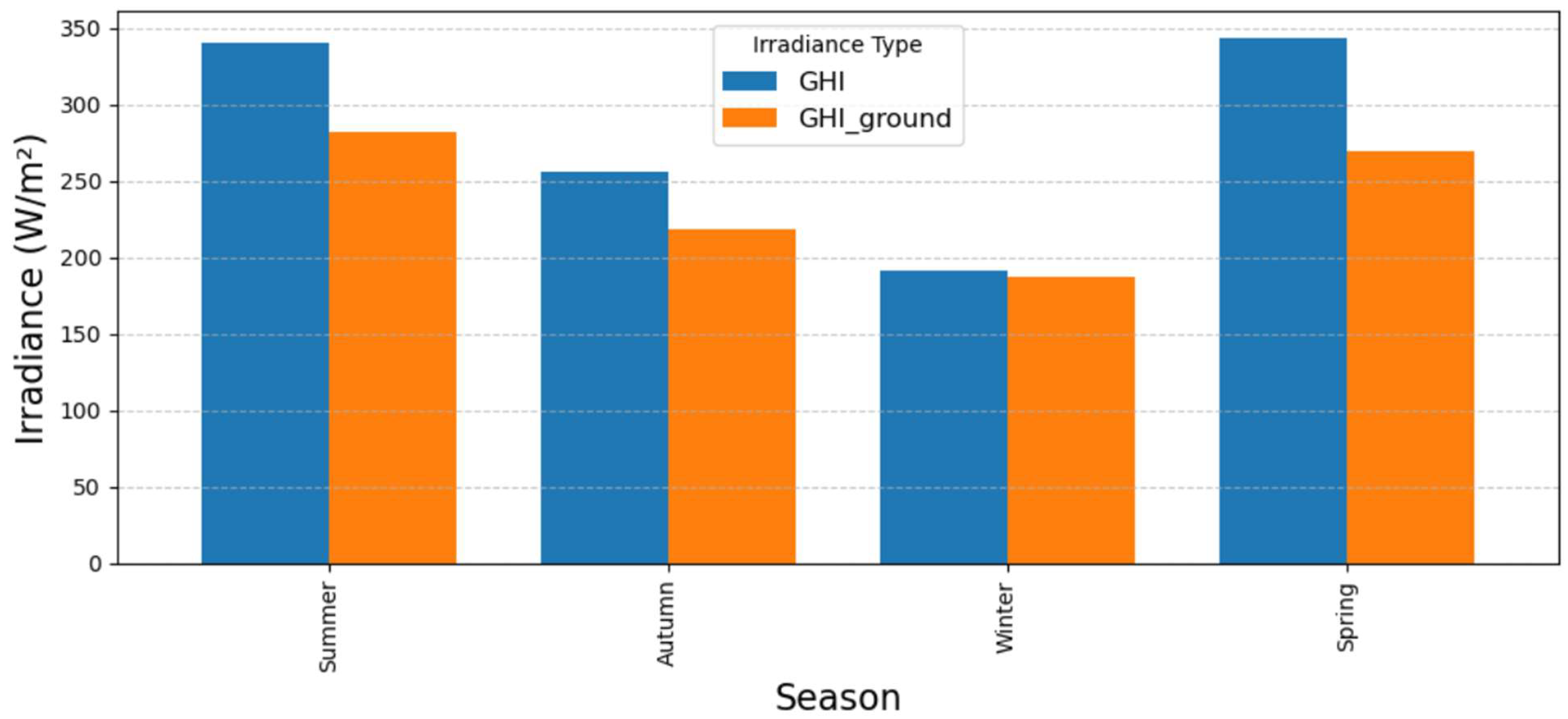
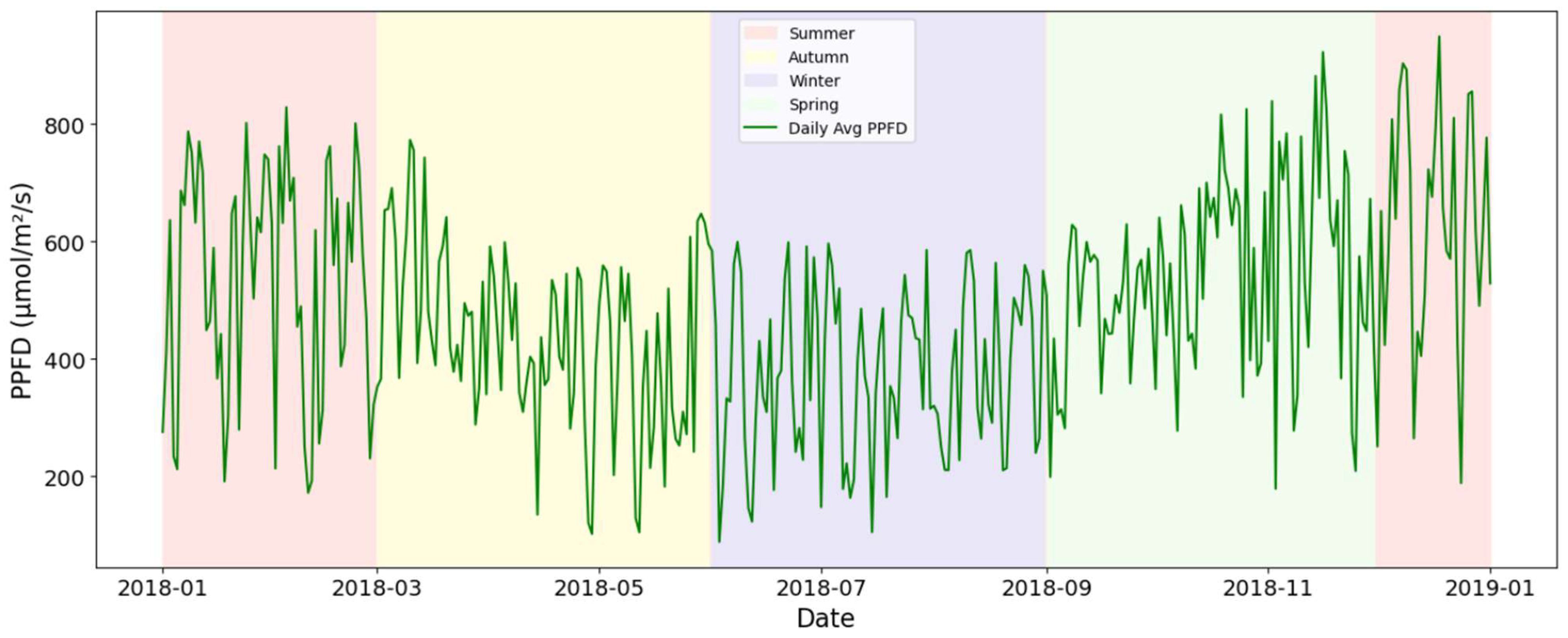
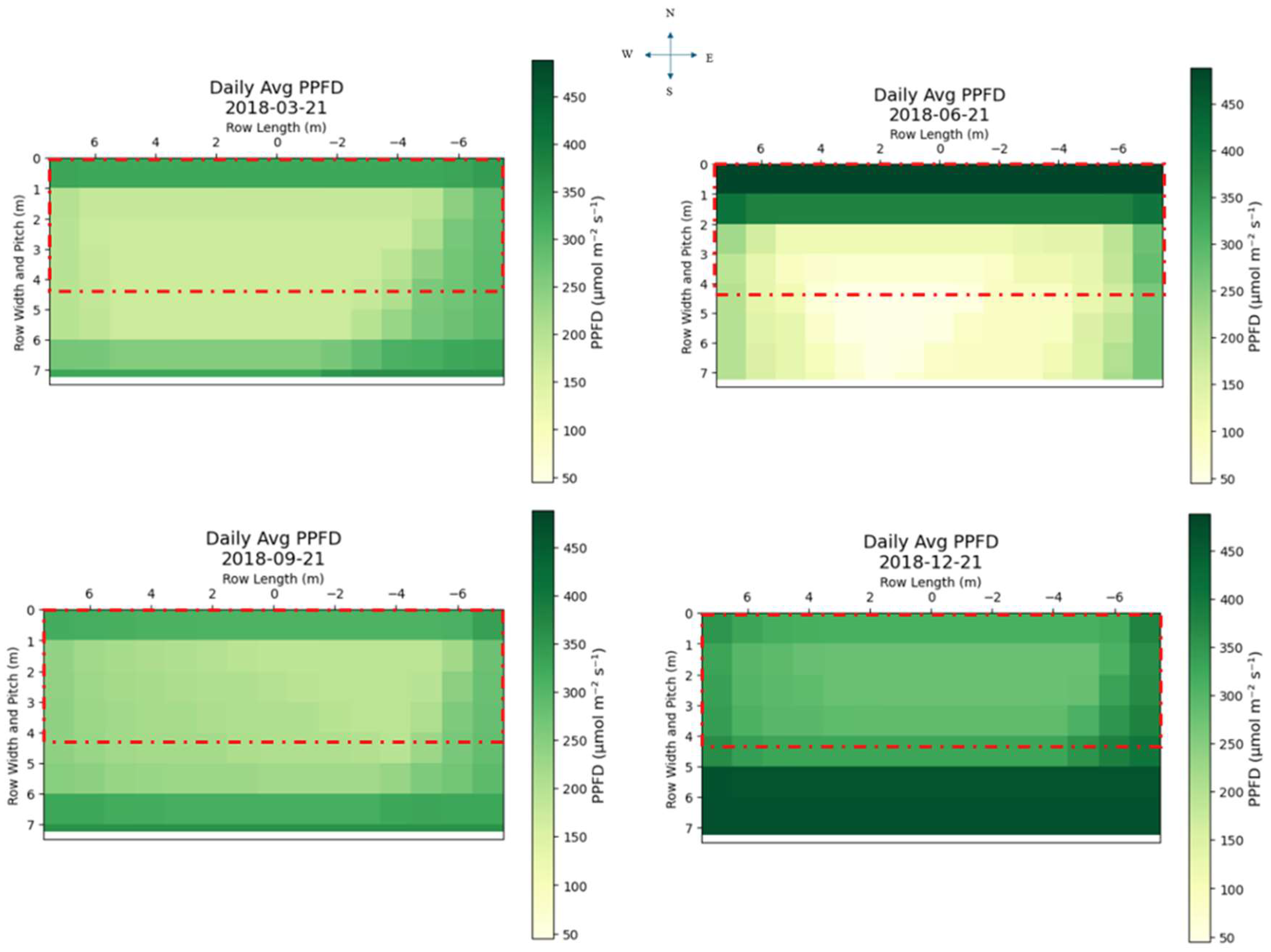

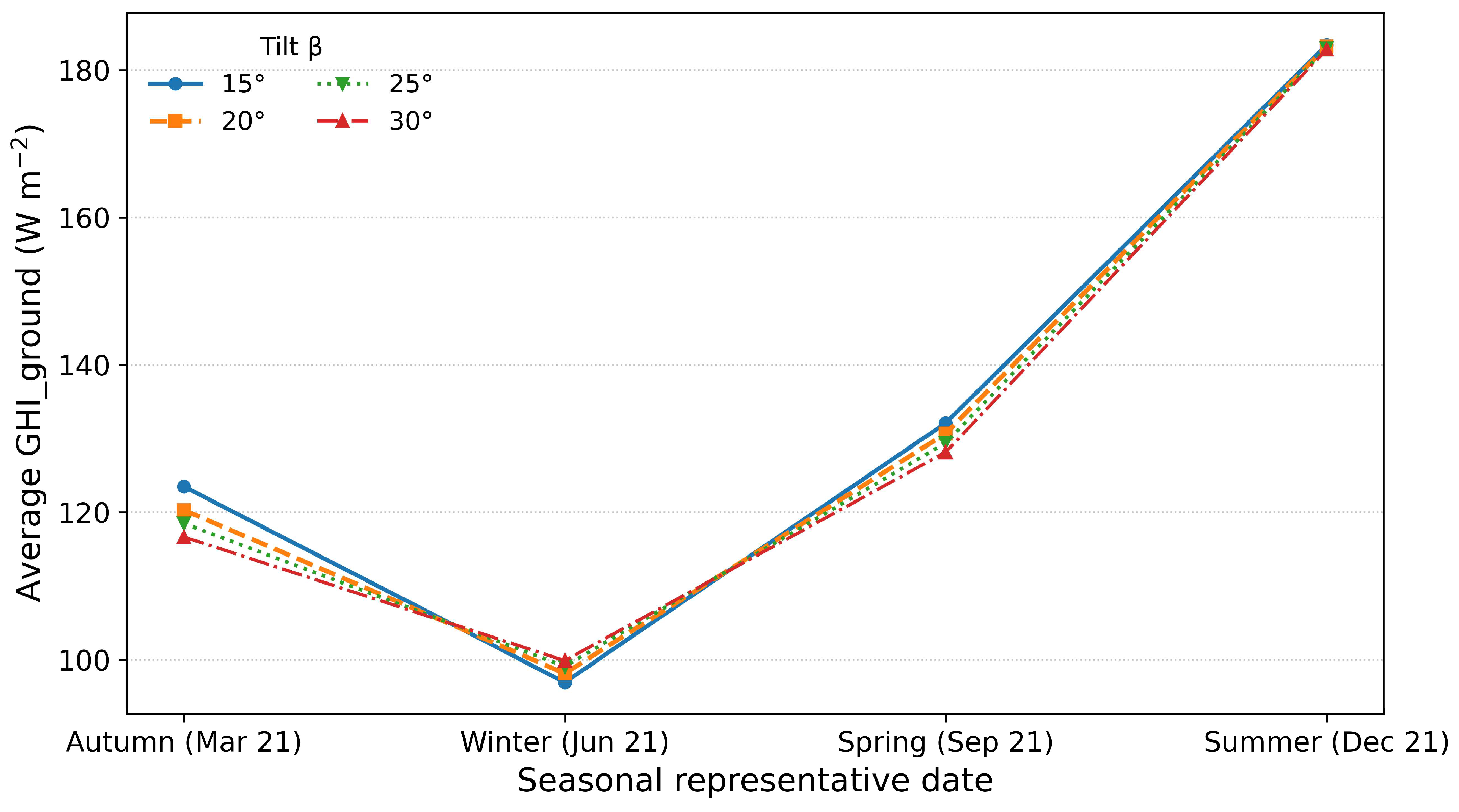

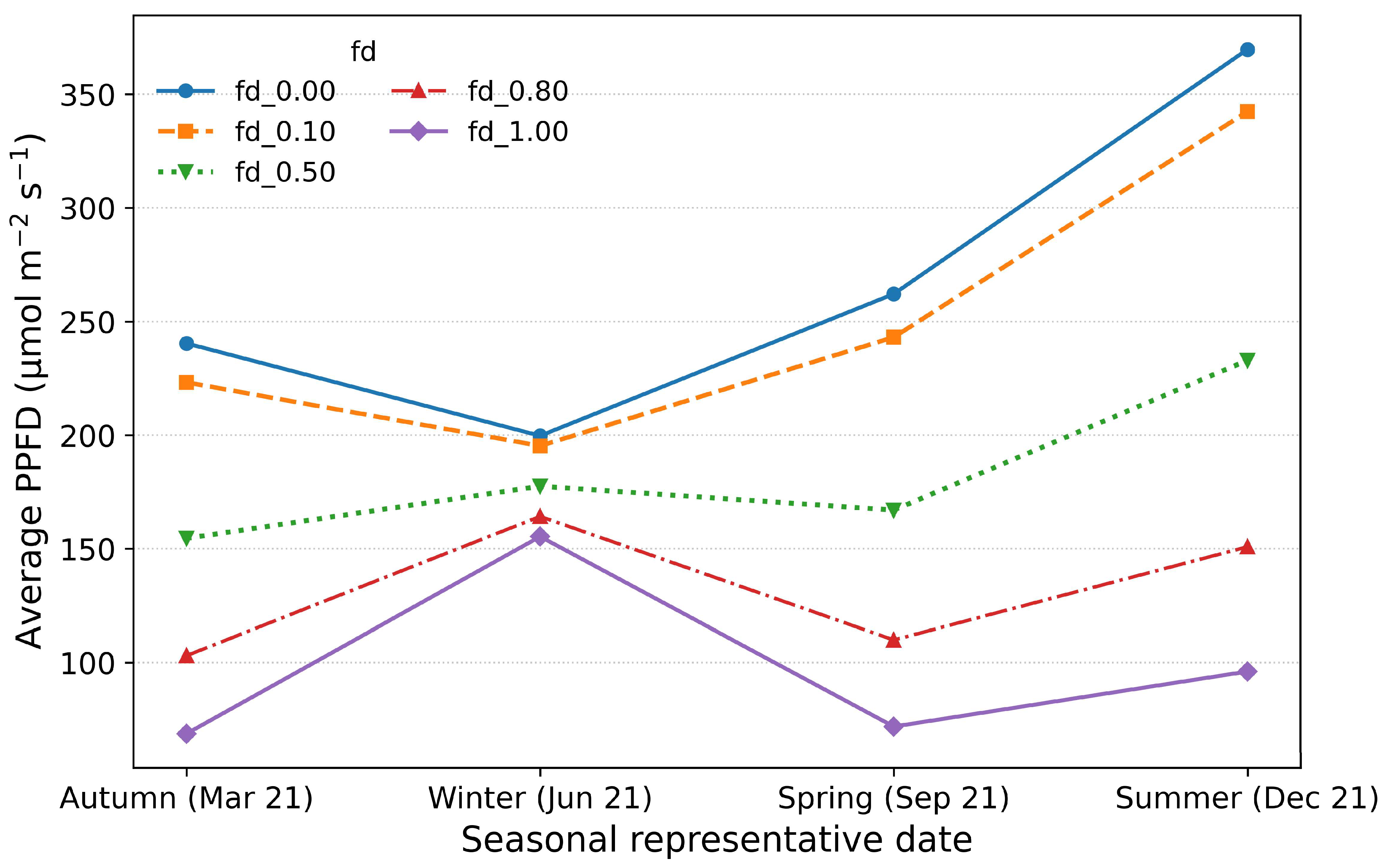
| Azimuth (deg) | −180 | −160 | −140 | −120 | −100 | −80 | −60 | −40 | −20 | 0 | 20 | 40 | 60 | 80 | 100 | 120 | 140 | 160 | 180 |
|---|---|---|---|---|---|---|---|---|---|---|---|---|---|---|---|---|---|---|---|
| Elevation (deg) | |||||||||||||||||||
| 90 | 0.59 | 0.59 | 0.59 | 0.59 | 0.59 | 0.59 | 0.59 | 0.59 | 0.59 | 0.59 | 0.59 | 0.59 | 0.59 | 0.59 | 0.59 | 0.59 | 0.59 | 0.59 | 0.59 |
| 80 | 0.63 | 0.62 | 0.61 | 0.60 | 0.58 | 0.56 | 0.56 | 0.53 | 0.52 | 0.52 | 0.52 | 0.53 | 0.56 | 0.56 | 0.58 | 0.60 | 0.61 | 0.62 | 0.66 |
| 70 | 0.67 | 0.66 | 0.63 | 0.66 | 0.58 | 0.54 | 0.50 | 0.47 | 0.46 | 0.46 | 0.46 | 0.47 | 0.50 | 0.54 | 0.58 | 0.61 | 0.63 | 0.66 | 0.67 |
| 60 | 0.72 | 0.70 | 0.66 | 0.62 | 0.57 | 0.51 | 0.45 | 0.41 | 0.38 | 0.38 | 0.38 | 0.41 | 0.45 | 0.51 | 0.57 | 0.62 | 0.66 | 0.70 | 0.72 |
| 50 | 0.78 | 0.75 | 0.69 | 0.63 | 0.56 | 0.48 | 0.40 | 0.33 | 0.29 | 0.29 | 0.29 | 0.33 | 0.40 | 0.48 | 0.56 | 0.63 | 0.69 | 0.75 | 0.78 |
| 40 | 0.85 | 0.81 | 0.73 | 0.64 | 0.55 | 0.44 | 0.32 | 0.23 | 0.18 | 0.16 | 0.17 | 0.23 | 0.32 | 0.44 | 0.55 | 0.64 | 0.73 | 0.81 | 0.85 |
| 30 | 0.79 | 0.75 | 0.73 | 0.65 | 0.53 | 0.38 | 0.22 | 0.09 | 0 | 0 | 0 | 0.09 | 0.22 | 0.38 | 0.53 | 0.65 | 0.73 | 0.75 | 0.79 |
| 20 | 0.66 | 0.62 | 0.61 | 0.61 | 0.48 | 0.28 | 0.06 | 0 | 0 | 0 | 0 | 0 | 0.06 | 0.28 | 0.48 | 0.61 | 0.61 | 0.62 | 0.66 |
| 10 | 0.30 | 0.29 | 0.33 | 0.36 | 0.28 | 0.05 | 0 | 0 | 0 | 0 | 0 | 0 | 0 | 0.06 | 0.28 | 0.36 | 0.33 | 0.29 | 0.30 |
| 0 | 1 | 1 | 1 | 1 | 1 | 1 | 1 | 1 | 1 | 1 | 1 | 1 | 1 | 1 | 1 | 1 | 1 | 1 | 1 |
| Season | Average Ground GHI (W/m2) | Average PPFD (μmol/m2/s) |
|---|---|---|
| Summer | 282.21 | 570.06 |
| Autumn | 218.3 | 440.96 |
| Winter | 187.65 | 379.06 |
| Spring | 269.71 | 544.81 |
| Plant | Genus | PPFD (μmol/m2/s) | DLI (mol/m2/d) |
|---|---|---|---|
| Blackberry | Rubus | 200–300 | 8–14 |
| Chrysanthemums | Chrysanthemum | 200–300 | 10–14 |
| Mint | Mentha | 200–400 | 10–20 |
| Parsley | Petroselinum crispum | 200–400 | 10–20 |
| Sage | Salvia officinalis | 200–400 | 10–20 |
| Garden Lettuce | Lactuca | 250–350 | 14–16 |
| Roses | Rosa | 350–450 | 18–22 |
| Tomatoes | Solanum lycopersicum | 350–800 | 22–30 |
| Strawberry | Fragaria | 400–600 | 17–28 |
| Turfgrass Cultivar | Summer | Winter | Spring | |||
|---|---|---|---|---|---|---|
| DLI (mol/m2/day) | PPFD (μmol/m2 /s) | DLI (mol/m2/day) | PPFD (μmol/m2/s) | DLI (mol/m2/day) | PPFD (μmol/m2/s) | |
| Tifway hybrid bermudagrass | 21 | 486.11 | 10.6 | 245.37 | 17.9 | 414.35 |
| TifGrand hybrid bermudagrass | 19.9 | 460.65 | 9.8 | 226.85 | 14.6 | 337.96 |
| Celebration common bermudagrass | 19.6 | 453.70 | 8.8 | 203.70 | 14.9 | 344.91 |
| TifBlair centipedegrass | 13.4 | 310.19 | 9.5 | 219.91 | 14.1 | 326.39 |
| Floratam St. Augustinegrass | 11.8 | 273.15 | 8.5 | 196.76 | 11.6 | 268.52 |
| Palisades zoysiagrass (japonica) | 11.2 | 259.26 | 8.2 | 189.81 | 11.2 | 259.26 |
| Captiva St. Augustinegrass | 10.9 | 252.31 | 8 | 185.19 | 11.5 | 266.20 |
| BA-417 zoysiagrass (matrella) | 10.8 | 250.00 | 7.3 | 168.98 | 10.6 | 245.37 |
| JaMur zoysiagrass (japonica) | 10.3 | 238.43 | 6.8 | 157.41 | 10.5 | 243.06 |
| Species/Group | PPFD Band Used (μmol m−2 s−1) | Suitability Below the Panels | Suitability at Edge/Inter-Row Bands | Notes |
|---|---|---|---|---|
| Low-light turf/cover (TifBlair centipede grass; Captiva St. Augustine grass; BA-417 zoysia; JaMur/Palisades zoysia) | 150–250 | Suitable as ground cover throughout the year; growth is slow in winter. | Suitable as ground cover throughout the year. | Best for soil protection and weed suppression where light is lowest. |
| Perennial ryegrass (Lolium perenne) | ~400 (optimum) | Generally not suitable in winter; may be marginal in spring or autumn only if PPFD reaches ~400. | Suitable in spring and autumn; generally suitable in summer. | May require water/nutrient inputs around its ~400 optimum. |
| Lettuce, parsley, mint, sage, cilantro | 300–600 | Not suitable below panels. | Suitable in spring and autumn; may be feasible in summer with careful management. | Typical moderate-light crops for semi-shade. |
| Strawberries | ~400–500 during active growth; dormant in winter | Acceptable during winter dormancy only; not suitable for active growth below panels. | Suitable for active growth in spring and summer. | Seasonality aligns with the site’s winter light deficit. |
| Tomatoes, roses (high-light) | >600 | Not suitable below panels. | Suitable in summer only and only in the brightest edge/inter-row bands. | High-light requirement limits placement and season. |
| Maize, sunflower (very high-light) | >800 | Not suitable below panels. | Not recommended within the PV footprint; requires open, unshaded areas. | Exclude from under-row and near-row zones. |
Disclaimer/Publisher’s Note: The statements, opinions and data contained in all publications are solely those of the individual author(s) and contributor(s) and not of MDPI and/or the editor(s). MDPI and/or the editor(s) disclaim responsibility for any injury to people or property resulting from any ideas, methods, instructions or products referred to in the content. |
© 2025 by the authors. Licensee MDPI, Basel, Switzerland. This article is an open access article distributed under the terms and conditions of the Creative Commons Attribution (CC BY) license (https://creativecommons.org/licenses/by/4.0/).
Share and Cite
Dhlamini, M.M.; Brent, A.C. The Impact of Fixed-Tilt PV Arrays on Vegetation Growth Through Ground Sunlight Distribution at a Solar Farm in Aotearoa New Zealand. Energies 2025, 18, 5412. https://doi.org/10.3390/en18205412
Dhlamini MM, Brent AC. The Impact of Fixed-Tilt PV Arrays on Vegetation Growth Through Ground Sunlight Distribution at a Solar Farm in Aotearoa New Zealand. Energies. 2025; 18(20):5412. https://doi.org/10.3390/en18205412
Chicago/Turabian StyleDhlamini, Matlotlo Magasa, and Alan Colin Brent. 2025. "The Impact of Fixed-Tilt PV Arrays on Vegetation Growth Through Ground Sunlight Distribution at a Solar Farm in Aotearoa New Zealand" Energies 18, no. 20: 5412. https://doi.org/10.3390/en18205412
APA StyleDhlamini, M. M., & Brent, A. C. (2025). The Impact of Fixed-Tilt PV Arrays on Vegetation Growth Through Ground Sunlight Distribution at a Solar Farm in Aotearoa New Zealand. Energies, 18(20), 5412. https://doi.org/10.3390/en18205412







